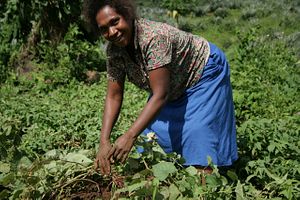The entrance to the government-run garden in Gozoruru, in Santa Isabel island, is littered with bug-bitten leaves, and many of the sweet potato stalks have started to brown and wilt under the unforgiving scorch of the midday sun. Planting was once a cut-and-dry process, with a field planted with yam seeds producing a full harvest within three months.
Now, throughout Solomon Islands, yams take at least five months to grow, their tubers pushed up through poor soil doused with unexpected rainfall during the dry season from April to October. Pests and disease flourish in the higher, damper temperatures, and sometimes only half of a planted garden bears fruit.
“The pests were always there, but now they come in numbers, and we don’t have any remedy for the new pests or plant diseases,” said Dominic Alebua, 59, a primary school teacher in Avuavu, on southern Guadalcanal island.
The communities near Gozoruru and Avuavu are far from sites where boats could regularly dock to bring supplies such as dry rice and tuna from Honiara – making self-reliance critical during the seven months of the year when only one or two ships pass by. Rough seas also make fishing a challenge, with people sometimes going weeks without their only source of protein.
“Sometimes we only eat bananas for three weeks. Or we skip lunch,” said Anthony Suava, 46, a local police officer in Avuavu.
Solomon Islands has been among the nations hardest hit by the impact of climate change, with sea levels rising up to 8 mm per year since 1993 – more than double the global average of 2.8 -3.6 mm – and temperatures rising 0.15 degrees since 1951. Each rainy season averages 300 mm rainfall, and this is projected to increase by 20 percent in the late 21st century, according to the International Climate Change Adaptation Initiative. With 85 percent of all people distributed throughout the 1000-island archipelago relying on the earth and sea for food, environmental changes shake the basis of survival for rural communities.
So, in 2012, the government and the UN Development Programme’s (UNDP) climate change adaptation project Strogem Waka Lo Community Fo Kai Kai (SWoCK), pidgin for enhancing community resilience, supported by the Adaptation Fund, began a series of experimental gardens, known as bulking sites, throughout Solomon Islands. Their plan was to test out which crop varieties will survive the barrage of ill weather brought by climate change, and distribute planting materials to farmers.
“We want to determine which ones are strong enough to grow in erratic conditions,” said Benjamin Tambe, the Ministry’s research officer based in Avuavu, who lives alone at the isolated site, tending to the garden and collecting growth data and weather patterns.
Flourishing Pests
Countries from all over the world have sent their seedlings for experimentation, including Peru, the U.S., Papua New Guinea, Denmark, Mexico and Taiwan. The tubers, planted in November this year, will be examined and rated next year to determine their hardiness against pests, heavy rainfall, soil erosion, and rising temperatures.
But there are more than 2,755 different pests flourishing in Solomon Islands, according to the Pacific Islands Pest List Database, and identifying the resistant crops will be an arduous process of trial and error, with constant adjustment to new conditions, according to the Ministry of Agriculture and Livestock – which, with SWoCK, plans to open a Plant Health Clinic (PHC) in the upcoming months. Community members will be able to bring in samples of plant materials ravaged by pests and disease for physical examination, diagnoses, and practical advice for treatment. Common pests include the taro beetle, taro worms, and the weevil. The Alomae-Bobone disease transmitted through mealy bugs can destroy more than half a field.
“The low-lying coastal areas used to be the only places infested, but now the pests are appearing in the cooler highland areas, a sign that the temperature is warming,” said Nixon Buka, the SWoCK Provincial Project Coordinator based in Isabel province.
Rotting Crops
By encouraging seasonal crop rotation with support from SWoCK, the ministry hopes to cut off the life cycle of the pest and control population growth. Planting different crop varieties, such as swamp taro (which thrives in swampy, wet conditions) will also ensure more tuber and vegetable varieties are available after heavy rainfall.
“The problem is that the food people like and have planted mono-crop for years is very vulnerable to pest attack,” said Buka.
The staple yams can only survive two to three days of rain, but others, such as the ubiquitous swamp taro, thrive in swampy wet conditions throughout the bush.
“If people don’t have sweet potato, they say there is a shortage of food. But [there are other things] they can plant and eat,” he stressed.
But the farmers have not given up hope that the experimental gardens will result in seeds and planting materials for their staple starches.
“We need to have our own taro and yam again,” said Alebua. “The farmers don’t give up, they keep making gardens in spite of pests and disease… it is part of our tradition,” said Alebua.
The pests are but one concern in the host of climate-related issues for Pacific Island state governments. The third international conference on Small Island Development States (SIDS) being held this week in Apia, Samoa is giving them an opportunity to discuss such issues, and to see how cooperation on initiatives such as seed swaps can mitigate the harsh impacts of climate change on communities.
Dana Maclean is a journalist covering Southeast Asia.
































